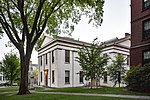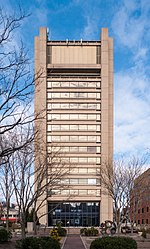Watson Institute for International and Public Affairs
1981 establishments in Rhode IslandBrown UniversityForeign policy and strategy think tanks in the United StatesPeace and conflict studiesPublic administration schools ... and 6 more
Public policy schoolsRafael Viñoly buildingsRealist think tanksResearch institutes of international relationsSchools of international relations in the United StatesSecurity studies

The Watson Institute for International and Public Affairs is an interdisciplinary research center at Brown University in Providence, Rhode Island. Its mission is to promote a just and peaceful world through research, teaching, and public engagement. The institute's research focuses on three main areas: development, security, and governance. Its faculty include anthropologists, economists, political scientists, sociologists, and historians, as well as journalists and other practitioners. The institute is directed by Edward Steinfeld, professor in the Department of Political Science, and director of the China Initiative at Brown University.
Excerpt from the Wikipedia article Watson Institute for International and Public Affairs (License: CC BY-SA 3.0, Authors, Images).Watson Institute for International and Public Affairs
Thayer Street, Providence
Geographical coordinates (GPS) Address Nearby Places Show on map
Geographical coordinates (GPS)
| Latitude | Longitude |
|---|---|
| N 41.82515 ° | E -71.39999 ° |
Address
Kassar House
Thayer Street 141-151
02912 Providence
Rhode Island, United States
Open on Google Maps









